Gift InsideGOLF this holiday season ($100 value for just $20!)
When it comes to sprinkler systems, an ounce of prevention can spare you more costly repairs down the line. Pulsating Sprinkler Head

We turn this week to mechanical issues, but not the kind related to your setup or your swing.
Our focus is sprinkler systems.
Fairways have them. Front lawns, too. And while these systems vary in their scale and sophistication, they often fall prey to similar problems.
Terry Buchen, a retired superintendent and a 54-year member of the Golf Course Superintendents Association of America, remains active in the industry as a consultant.
We asked him about common irrigation glitches and hiccups, and what supers and homeowners can do about them.
Nothing lasts forever. The average lifespan for a golf-course irrigation system is 8 to 10 years in warm climates, and 10 to 12 years in colder climates and transition zones, Buchen says. Home systems, which tend to be less sophisticated, have slightly shorter lifespans.
While there’s no way to stop the indignities of aging, it’s worth keeping watch. Most courses have anywhere from 800 to 2,000 sprinkler heads. At clubs with healthy budgets, full-time irrigation techs inspect those sprinkler heads roughly once a week, Buchen says.
No homeowner in their right mind is apt to keep up that kind of inspection schedule. But it’s a good idea to pay attention to how your sprinkler heads are performing. An ounce of prevention can spare you more costly repairs down the line.
Watering a sidewalk or a cart path is a waste. When these things happen, a mechanical problem is often to blame. At courses, most sprinkler heads operate on gear-driven arcs that are adjustable up to 360 degrees. Home systems commonly rely on pop-up sprinkler heads with pre-set arcs. In either case, the arcs can go out of whack.
The problem might be old-fashioned wear and tear, in which case the sprinkler head will need to be replaced. But it’s also possible that something is clogged or jammed, and you might be able to fix the problem yourself.
“First things first, I’d see if you can make it a DIY job,” Buchen says. “You can learn how to fix almost anything on YouTube.”
If that fails, call a pro. You can find plenty of them online, too.
Here, again, it might be that the sprinkler head has bit the dust and needs to be replaced. But it’s also possible the system has been jammed by grass, dirt or other debris.
This is easy enough to check, Buchen says. Simply unscrew the sprinkler head and check the nozzle. If it’s clogged, try cleaning it out with a paper clip. Just below the nozzle is a fine-mesh screen, designed to catch gunk. These screens can get clogged, too. But they’re a hassle to clean, Buchen says. And since they’re relatively inexpensive to replace, you’re often better off just buying new ones.
At home, Buchen replaces those screens every two years.
In cold climates where temperatures drop low enough for water to freeze, irrigation systems need to be emptied before winter. Otherwise, all havoc can break loose in the form of burst pipes, busted sprinkler heads and more.
Superintendents use powerful compressors to flush their irrigation systems before winter. Homeowners in cold climates should do the same. If you’re handy and confident, you can do this on your own. But don’t feel obliged. Buchen, who lives in Boise, Idaho, outsources the job.
A golf, food and travel writer, Josh Sens has been a GOLF Magazine contributor since 2004 and now contributes across all of GOLF’s platforms. His work has been anthologized in The Best American Sportswriting. He is also the co-author, with Sammy Hagar, of Are We Having Any Fun Yet: the Cooking and Partying Handbook.

Micro Irrigation Sprinkler Heads GOLF.com and GOLF Magazine are published by EB GOLF MEDIA LLC, a division of 8AM GOLF